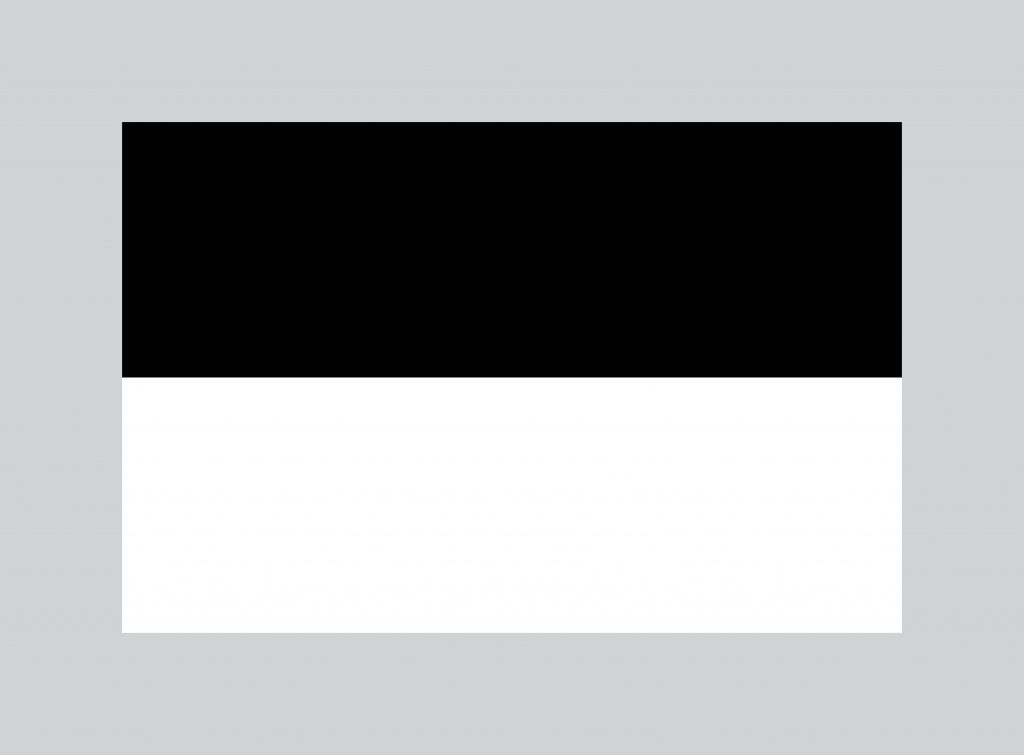
figure a
THE PRIMAL PHENOMENON OF COLOUR
Henri Bortoft
When Goethe saw that the prismatic colours appeared only where there was a boundary, he thought that the theory of the colours being contained already in the light was wrong. He decided that there must be light and dark for the colour phenomenon to arise, not just light alone. Anyone who has a prism can repeat Goethe’s observations. Take the card (figure a) with a straight boundary between the black and white regions and look at the boundary through the prism. Holding the prism so that it is oriented like the roof of a house turned upside down, look through the slanted side facing you toward the card. If the card is orientated so that the black region is above the white, colours will appear in the white region just below the black, with red nearest the boundary, then orange, and yellow furthest away. If you rotate the card so that the white region is above the black, the colours also appear at first to be in the white region, but careful observation reveals that they are in fact being seen in the black region just below the white. Again, the colours are parallel to the boundary, but with this orientation of the card the colours are blues, with light blue nearest to the boundary and violet furthest into the black.
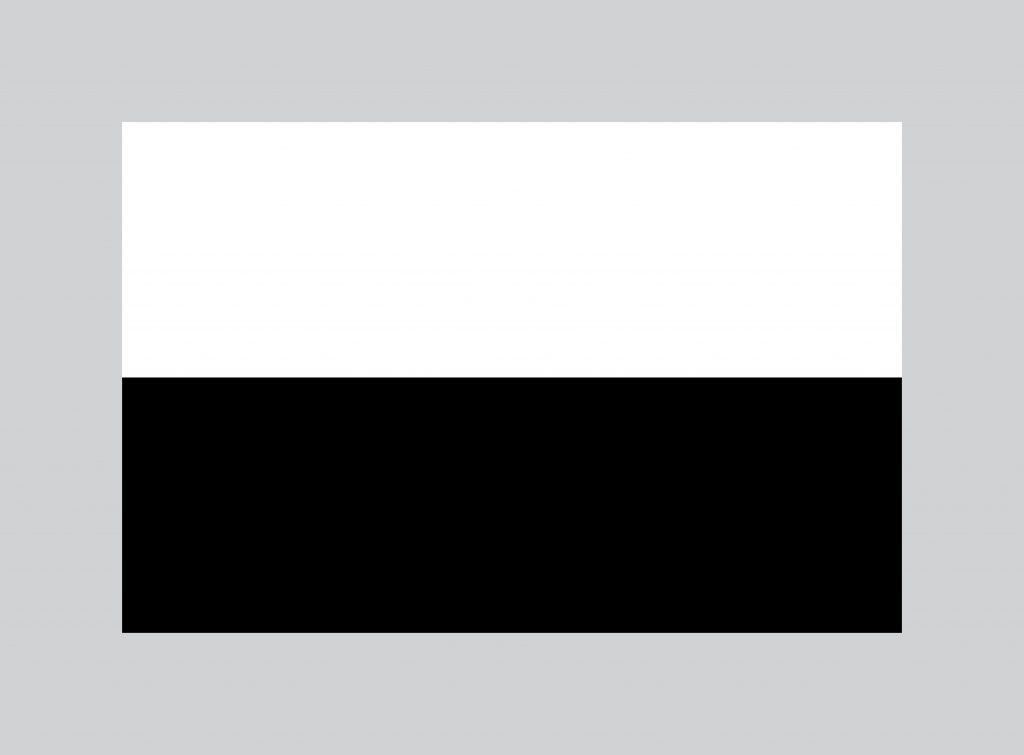
figure a (reversed)
When observing the phenomenon of colour in Goethe’s way it is necessary to be more active in seeing than we are usually. The term “observation” is in some ways too passive. We tend to think of an observation as just a matter of opening our eyes in front of the phenomenon, as if it were something that happens to us when visual information flows in through the senses and is registered in consciousness. Observing the phenomenon in Goethe’s way requires us to look, as if the direction of seeing were reversed, going from ourselves towards the phenomenon instead of vice versa. This is done by putting attention into seeing, so that we really do see what we are seeing instead of just having a visual impression. It is as if we plunged into seeing. In this way we can begin to experience the quality of the colours.
But Goethe’s encounter with the phenomenon did not stop at this stage of observation. He would then repeat the observations he had made, but this time doing so entirely in his imagination without using the apparatus. He called this discipline exakte sinnliche Phantasie, which can be translated as “exact sensorial imagination”. In this case it would mean trying to visualise making the observations with the prism, and seeing the qualities of the different colours in the right order at a boundary as if we were producing them. This would then be transformed in imagination into an image of the colours with the boundary in the opposite orientation, and then transformed back again. The process can be repeated several times. The aim is to think the phenomenon concretely in imagination, and not to think about it, trying not to leave anything out or to add anything which cannot be observed. Goethe referred to this discipline as “recreating in the wake of ever-creating nature”. Combined with active seeing, it has the effect of giving thinking more the quality of perception and sensory observation more the quality of thinking. The purpose is to develop an organ of perception which can deepen our contact with the phenomenon in a way that is impossible by simply having thoughts about it and working over it with the intellectual mind.
Although the unity in the colour phenomenon may begin to be intimated by working with the prism in the way described above, it is difficult for it to emerge clearly in these circumstances. This is because the appearance of the colours in this case depends on the peculiar shape of the piece of glass. Goethe believed that this was a complicating factor, and because of this the phenomenon of prismatic colours was not a suitable basis from which to understand the origin of colours. He also believed that there must always be some instance in nature where a phenomenon occurs in the simplest way possible, without any secondary factors to disguise what is essential. He had already recognised from his first observation with the prism that light and dark were necessary “to call forth the colours”. So if he could find an instance in nature of the “coming into being” of colours out of light and dark alone, then he would have read the origin of colours directly in nature itself. He called such an instance an Urphänomen, which can be translated “primal phenomenon”, and he described it as “an instance worth a thousand, bearing all within itself”. He saw the proper task of physics as being to find the primal phenomenon for any particular field of study, and to resist the temptation to try to go beyond it by imagining a hidden mechanism as Newton and others did.
Goethe discovered the primal phenomenon of colour in the colours of the sun and the sky. On a clear day the colour of the sky overhead is a brilliant blue, which becomes lighter in shade as the angle of vision decreases towards the horizon. But if we were to go up a mountain, the colour overhead would progressively darken until it became violet. If we could go higher still, it would darken further until it became black. When we look at the sky overhead, we are seeing darkness through the atmosphere which is illuminated by the sun. The quality of the blue we see depends on the thickness of the atmosphere through which we are seeing the darkness of outer space. The greater the thickness of the atmosphere, the lighter the shade of blue. Goethe recognised that the role of the atmosphere here is to be a light-filled medium because it is illuminated by the sun. So when we look at the sky we are looking at dark through light, and the effect of this is to lighten the dark progressively into lighter shades of blue as the proportion of the light-filled medium increases. Thus the origin of blue is the lightening of dark which occurs when dark is seen through light. In this way Goethe learned to see the “coming into being” of the various shades of blue in the phenomenon itself.
The origin of red and yellow can be discovered in the changing colour of the sun. When it is overhead on a clear day the sun is yellow, and it darkens in colour towards red as it moves closer to the horizon at sunset. In this case we are looking at light through the atmosphere, and the role of this medium is now to darken what is seen in proportion as its thickness increases. If we were to go higher up, the sun would become whiter as the atmospheric thickness decreased. Thus the origin of yellow, orange, and red is the darkening of light which occurs when light is seen through dark. Here also Goethe learned to see the “coming into being” of the colours in the phenomenon itself, so that from this “instance worth a thousand, bearing all within itself” he could understand how they arise out of light and dark exclusively.
Now we can read the colours of the sun and the sky in the prismatic colours. It is well worthwhile doing this by exact sensorial imagination. Beginning with the colour of the sky, we can visualise the change in quality of the colour from black through to pale blue as the thickness of the atmosphere increases. When we visualise the colours formed with the prism using the card (figure a) with a straight boundary, when the white region is above the black, we can see the same order in the qualities of the prismatic colours as in the colours of the sky. We can recognise that what we are seeing here are different degrees of the lightening of dark. Repeating this exercise in imagination with the card (figure a) in the opposite orientation, again we can recognise the same order in the qualities of the colours, but this time we are seeing the darkening of light.
Although the practice of thinking the phenomenon concretely is irksome to the intellectual mind, its value for developing perception of the phenomenon cannot be overestimated. The practice of it shows how this comes about from the demand which it makes on us to visualise the phenomenon comprehensively. It also shows how the demand to produce the phenomenon for ourselves helps thinking to enter into the coming into being of the phenomenon instead of analysing what has already become. What Goethe discovered in this way was a dynamical polarity in the colour phenomenon. As well as the unity within the quality of the colours in each orientation of the boundary, there is also a unity between the two different colour phenomena. This is the unity of a polarity, like positive and negative electric charge. Because one and the same boundary can be in two different orientations with respect to the prism, these two colour phenomena are really inseparable. Goethe described this polarity as “the deeds and sufferings of light”, but this is already a second-degree polarity. The primary polarity is the unity of light and dark, and when we interpret light and dark analytically, we often miss the fact that we cannot have one without the other.
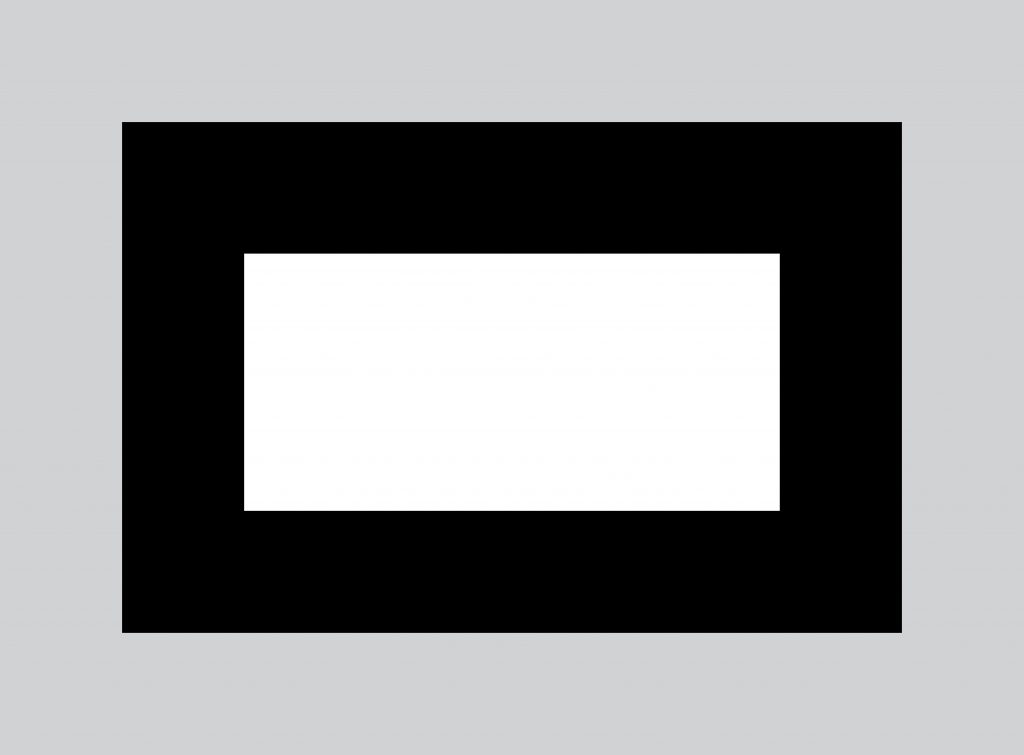
figure b
It is possible to have both “poles” of the colour phenomenon present simultaneously. Look through the prism at the card (figure b) with a broad white band on a black background. If we now imagine the white space shrinking in the vertical direction so that the two horizontal boundaries come closer together, a point will be reached where the two polar phenomena meet and overlap. We can find out what happens when they do by looking at the card (figure c) with a narrow white band on a black background. Where they meet we see green for the first time, and there is now something like the “spectrum of light” which Newton described, but this has been reached in a very different way.
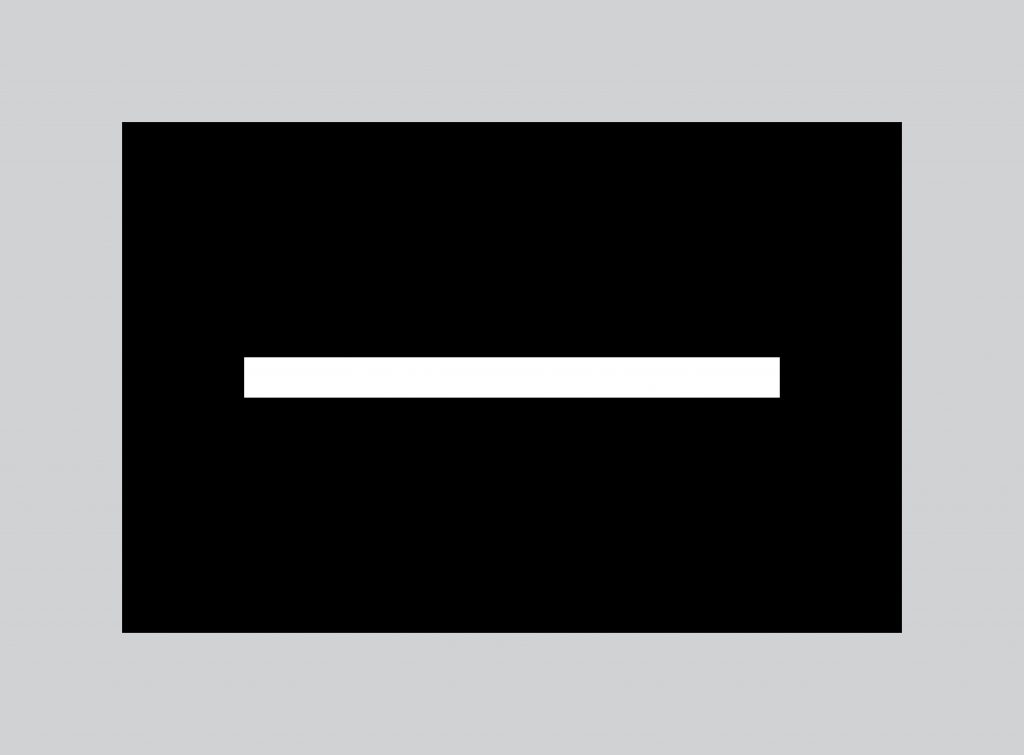
figure c
When the prismatic colours are understood in Goethe’s holistic way, the quality of each colour becomes something which is intelligible in itself and not just an accident. In Newton’s account of the origin of the colours there is no reason why the colour “red” has the quality of red, or why “blue” has the quality of blue, or why the colours are in the order observed and not in some other order. The intelligibility of the colours in themselves disappears in the analytical approach, and what is left seems to be merely contingent. It is no answer to be told that the order the colours appear in is the numerical order of their wavelengths, and that red has the quality of red because its wavelength is seven-tenths of a millionth of a meter, whereas violet has the quality of violet because its wavelength is four-tenths of a millionth of a meter. There is simply no way in which these qualities can be derived from such quantities. But it is very different when the colours are seen comprehensively in Goethe’s way. The order of the colours is now necessary instead of contingent, and hence the quality of each particular colour becomes intelligible in itself instead of appearing accidental.
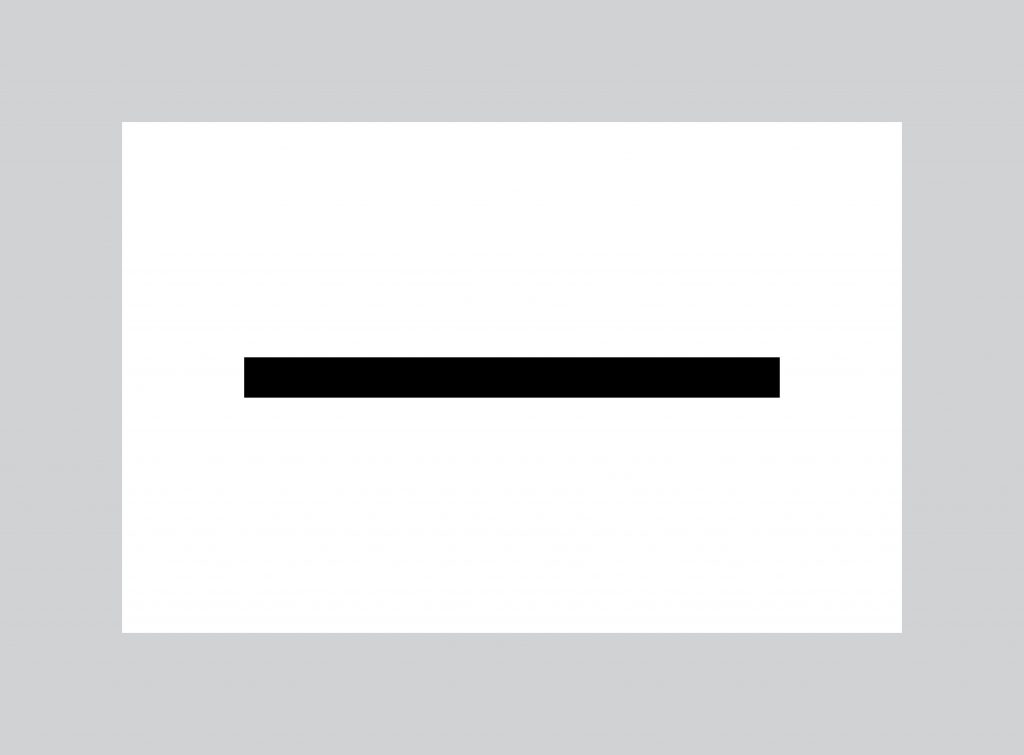
figure d
A particularly vivid illustration of the difference between these two approaches to colour is given by looking at the white card (figure d) with a narrow dark strip. Looking through the prism, the order of the colours is seen to be inverted compared with the previous case. Now violet and red overlap, instead of yellow and light blue, and where they meet a ruby-magenta colour appears instead of green. So the order of the colours from the top border downwards is blue, violet, ruby-magenta, red, orange, yellow. This is not mentioned by Newton. But that is not surprising, since it would have to be called the “spectrum of dark”, and this would be impossible if the colours were derived from light alone in the way that Newton believed.